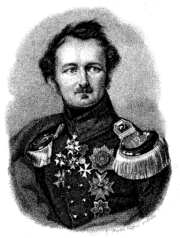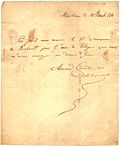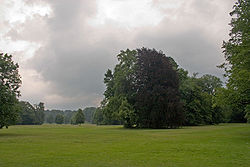- Hermann, Fürst von Pückler-Muskau
-
See also: Pückler and Muskau
Prince
 Hermann Ludwig Heinrich von Pückler-Muskau (help·info) (born as Count Pückler, from 1822 Prince) (30 October 1785 – 4 February 1871) was a German nobleman, who was an excellent artist in landscape gardening and wrote widely appreciated books, mostly about his travels in Europe and Northern Africa, published under the pen name of "Semilasso".
Hermann Ludwig Heinrich von Pückler-Muskau (help·info) (born as Count Pückler, from 1822 Prince) (30 October 1785 – 4 February 1871) was a German nobleman, who was an excellent artist in landscape gardening and wrote widely appreciated books, mostly about his travels in Europe and Northern Africa, published under the pen name of "Semilasso".Contents
Life
He was born at Muskau Castle (now Bad Muskau) in Upper Lusatia, then ruled by the Electorate of Saxony. He served for some time in a cavalry regiment at Dresden, and afterwards travelled through France and Italy, often by foot. In 1811, after the death of his father, he inherited the big Standesherrschaft (barony) of Muskau. Joining the war of liberation against Napoleon I of France, he left Muskau under the General Inspectorate of his friend, the writer and composer Leopold Schefer. As an officer under the Duke of Saxe-Weimar he distinguished himself in the field and was made military and civil governor of Bruges.
After the war he retired from the army and visited England, where he remained about a year, visiting Covent Garden and Drury Lane (admiring Eliza O'Neill), studying parks and the High Society, being himself a member of it. In 1822, in compensation for certain privileges which he resigned, he was raised to the rank of "Fürst"[1] by King Frederick William III of Prussia. In 1817 he had married the Dowager Countess Lucie von Pappenheim, née von Hardenberg, daughter of Prussian statesman Prince Karl August von Hardenberg; the marriage was legally dissolved after nine years, in 1826, though the parties did not separate and remained on amicable terms.
Again he visited England, where he spent nearly two years in search of a wealthy second wife capable of funding his ambitious gardening schemes and became something of a celebrity in London society. On his return home he published a not entirely frank account of his time in England. The book was an enormous success in Germany, and also caused a great stir when it appeared in English as Tour of a German Prince (1831-32). Being a daring character, he subsequently travelled in Algeria, Tunisia, Egypt and Sudan and explored ancient Nubia. He is documented as of having visiting the site of Naqa in modern day Sudan in 1837. At the slave market of Cairo he was enchanted by an Ethopian girl in her early teens whom he promptly bought and named Mahbuba ("the beloved"). Together they continued a romantic voyage in Asia Minor and Greece. In Vienna he introduced Mahbuba to the European high scociety, but the girl developed tuberculosis and died in Muskau in 1840. Later he would write that she was “the being I loved most of all the world.”[2]
He then lived at Berlin and Muskau, where he spent much time in cultivating and improving the still existing Muskau Park. In 1845 he sold this estate, and, although he afterwards lived from time to time at various places in Germany and Italy, his principal residence became Schloss Branitz near Cottbus, where he laid out another splendid park.
Politically he was a liberal, supporting the Prussian reforms of Freiherr vom Stein. This, together with his pantheism and his extravagant lifestyle, made him slightly suspect in the society of the Biedermeier period.
In 1863 he was made an hereditary member of the Prussian House of Lords, and in 1866 he attended — by then an octogenarian — the Prussian general staff in the Austro-Prussian War. In 1871 he died at Branitz, and, in accordance with instructions in his will, his body was cremated.
The artist
As a landscape gardener, he is considered to be an outstanding artist on a European level.
As a writer of books of travel he holds a high position, his powers of observation being keen and his style lucid, animated and witty. This is most evident in his first work Briefe eines Verstorbenen (4 vols, 1830–1831), in which he expresses many independent judgments about England and other countries he visited in the late 1820s and about prominent people he met. Among his later books of travel are Semilassos vorletzter Weltgang (3 vols, 1835), Semilasso in Afrika (5 vols, 1836), Aus Mehemed Ali's Reich (3 vols, 1844) and Die Rückkehr (3 vols, 1846–1848). He is also the author of the still famous Andeutungen über Landschaftsgärtnerei (1834, "Remarks on landscape gardening"), the only book he published under his own name.
There are as well drawings and caricatures by his hand, but he did not publish them.
Publications
- Briefe eines Verstorbenen (4 vols, 1830-31 (including a description of the Park of Warwick, which influenced strongly Edgar Allan Poe's The Park of Arnheim)[3]
- Tour of a German Prince, 4 vols, London, Wilson 1831-32 (translation of Briefe eines Verstornenen by Sarah Austin)
- Andeutungen über Landschaftsgärtnerei[,] verbunden mit der Beschreibung ihrer praktischen Anwendung in Muskau (the only publication featuring him as author), 1834
- Tutti frutti; aus den Papieren des Verstorbenen., 5 vols, 1834
- Semilassos vorletzter Weltgang, 3 vols, 1835
- Semilasso in Afrika, 5 vols, 1836
- Der Vorläufer, 1838
- Jugend-Wanderungen, 1835
- Südöstlicher Bildersaal (on Greece), 1840
- Aus Mehemed Ali’s Reich (on Egypt), 3 vols, 1844
- Die Rückkehr, 3 vols, 1846–48
- Briefwechsel und Tagebücher des Fürsten Hermann von Pückler-Muskau (letters and diaries), 9 vols, ed. Ludmilla Assing, Hamburg 1873-76, Bern ²1971
- Liebesbriefe eines alten Kavaliers. Briefwechsel des Fürsten Pückler mit Ada von Tresckow (love letters), ed. Werner Deetjen, 1938
- Bettina von Arnim/Hermann von Pückler-Muskau: »Die Leidenschaft ist der Schlüssel zur Welt«. Briefwechsel 1832-1844, complete edition with commentary by Enid Gajek and Bernhard Gajek, Cotta, Stuttgart 2001, ISBN 3-7681-9809-X
Fürst-Pückler-Eis
His name is still remembered in German cookery through a sweet called Fürst-Pückler-Eis (Prince Pückler ice-cream), very similar to Neapolitan ice cream - not invented by him, but named in his honour.
Fürst Pückler is also mentioned at the conclusion of the novel 2666 by Roberto Bolaño in reference to the dessert bearing his name, in this case, Neapolitan ice cream. He becomes an example of one's posterity being defined by accomplishments of lesser significance.
References
- Bowman, Peter James (2010). The Fortune Hunter: A German Prince in Regency England. Oxford: Signal Books. http://www.signalbooks.co.uk/book.php?a=1904955711.
- Ludmilla Assing-Grimelli, ed., Pückler-Muskaus Briefwechsel und Tagebücher ("Pückler-Muskau's letters and diaries", 9 vols., Hamburg 1873-1876, reprinted Bern 1971)
- Ludmilla Assing, Fürst Hermann von Pückler-Muskau, 1873
- Eduard Petzold, Fürst Hermann von Pückler-Muskau in seiner Bedeutung für die bildende Gartenkunst ("Prince Hermann von Pückler-Muskau - his impact on landscape gardening"), 1874
Notes
- ^ Regarding personal names: Fürst is a title, translated as (Sovereign) Prince, not a first or middle name. The female form is Fürstin.
- ^ Mahbuba, the Beloved, Capital, November 2006
- ^ Bettina Clausen, Edgar Poe - Der Park von Arnheim, in: Bettina Clausen/Lars Clausen (eds.), Spektrum der Literatur, 15th ed., Bertelsmann Lexikon Verlag, Gütersloh 1990
External links
Categories:- 1785 births
- 1871 deaths
- 18th-century German people
- 19th-century German people
- 18th-century Prussian people
- 19th-century Prussian people
- 19th-century artists
- 19th-century writers
- German explorers
- German landscape architects
- German military personnel of the Napoleonic Wars
- German writers
- German travel writers
- Members of the Prussian House of Lords
- German nobility
- Silesian nobility
- Saxon nobility
- People from the Electorate of Saxony
- People from Bad Muskau
Wikimedia Foundation. 2010.




